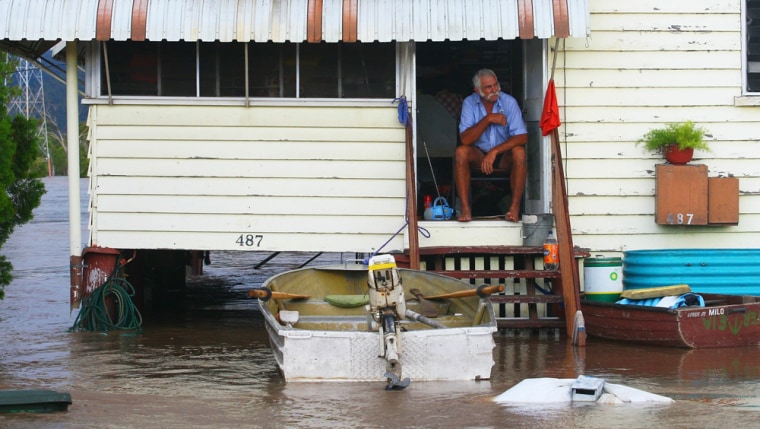Some residents of waterlogged northeast Australia returned to homes caked in sludge and nervously watched the skies for more rain Friday while waiting for swollen rivers to recede.
The worst appeared to have passed from flooding that covered an area the size of France and Germany in murky brown water for longer than a week, but torrents still posed dangers in partly-submerged towns in Queensland state and progress on assessing damage and rebuilding was slow.
On Friday, police banned boats from the swollen river coursing through the city of Rockhampton that is expected to remain near its peak for another 10 days.
The scope of the damage is not yet known, and fully repairing all of the infrastructure washed away or ruined could take years, the army general heading recovery efforts said.
Preliminary damage estimates were placed at $5 billion.
"We still don't know what it looks like underwater," Maj. Gen. Mick Slater told reporters in Rockhampton, where people for days have waded through water that was waist-deep in places. "Major roads, rail lines and bridges are all damaged, but we don't know yet how much."
"There are some aspects of the rebuilding of infrastructure that will take, potentially, years," he added.
Worst flooding in 50 years
Caused by tropical rains that fell for days, starting just before Christmas, the widespread nature of the flooding makes it Australia's worst in some 50 years.
Some 1,200 homes in 40 communities were inundated and almost 11,000 more have water damage. Nearly 4,000 people were evacuated, and police have reported 10 deaths in swollen rivers or floodwaters in Queensland since late November.
The rain has also hit the country's coal industry, which may be disrupted for months after key rail and road links were washed away, while some infrastructure could take years to repair.
The floods have swamped mines, paralyzing operations that produce 35 percent of Australia's exportable coal. Australia accounts for two-thirds of global exports of coking-coal, needed to make steel.
Heavy rain fell on some areas Friday and could last through the weekend. The rains aren't expected to increase flooding but could delay recovery and prolong the crisis.
'Just phenomenal'
The news for those in flooded areas Friday ranged from good, to bad, to little change at all.
Some of the 150 residents of the town of Condamine drove home in a convoy on Thursday for the first time since military helicopters helped evacuate everyone on Dec. 30.
"Nothing does justice to the devastation you come back to; it's just phenomenal," said bar owner Shane Hickey. "Everything is gone. The water just took everything with it.
"All the grass is mud, all the plants have been torn out of the ground, the trees have gone over and are just covered in silt and mud," he said.
The town has no drinking water, and Mayor Ray Brown said electricians, plumbers, portable toilets and water and food were being brought in.
Farther south, people in St. George were watching floodwaters inch higher by the hour on the earth-and-sandbag levees they rushed to build around homes. The flood peak was forecast lower, meaning fewer than 30 homes in the town of some 2,500 people were at risk.
In Rockhampton, the largest community hit, the floodwaters peaked two days ago but were steady Friday after inundating large parts of the city of 75,000 people. Small motorboats have replaced cars as the main way to get around in the worst-hit suburbs.
Police declared a "no-go" zone for boats on a section of the flooded Fitzroy River because live power lines hung too close to the water.
"Traveling through the floodwaters at this location is extremely dangerous due to low-lying power lines," said Inspector Peter Flanders. "It is important that the power to the Rockhampton sewerage treatment plant remains switched on."
